The Dogs of Fall or College Dog Mascots
Page 2
Page 2
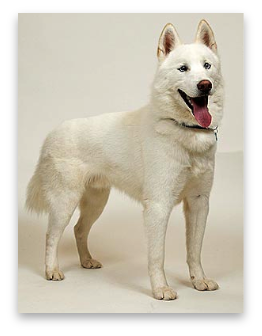
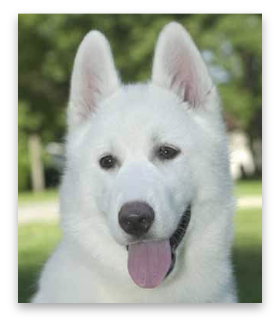
Siberian Huskies are well represented among college mascots. One of the most famous is Jonathan, mascot for the University of Connecticut. Named after Revolutionary Governor Jonathan Trumbull, the first Jonathan was purchased in 1935. During the 1960s, Alaska was devastated by a massive earthquake and UConn students sent donations. To repay their kindness, students at the University of Alaska sent a Husky who would become Jonathan VII. In 1970, protest exploded on college campuses in the US in opposition to the Vietnam War. The student senate voted to sell Jonathan because he "represented the establishment." Fortunately, a petition saved the mascot. Today, UConn's sparkling white Siberian Husky Jonathan XIII is in demand for appearances and is actively involved in a therapy program with children and the elderly.
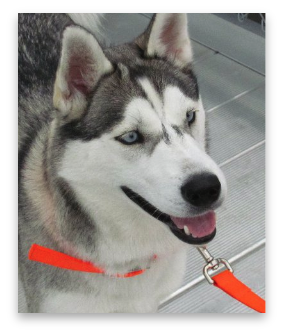
Houston Baptist University chose the name Huskies and acquired their first mascot in 1965. Wakiza II, better known as Kiza, is the seventh Siberian Husky to serve as official mascot. She was adopted by the school from Husky Haven, a rescue group. Kiza has gone from an abandoned puppy to star of the show. She attracts attention wherever she goes and travels with her own entourage. Known as The Sled Team, and led by the Head Musher, this group of volunteer students, chauffeurs Kiza around and makes sure she gets lots of petting and care.
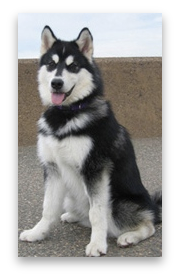
The University of Washington has earned a reputation for the excellence of their Husky teams. Their mascot, however, is not a Husky, but an Alaskan Malamute. The college adopted their first mascot in 1922. Frosty I lived in the Sigma Alpha Epsilon fraternity house at night and, by day, roamed the campus and the surrounding neighborhoods. A local cab company returned the dog to the frat house free of charge. Frosty went along with the football team to the 1924 Rose Bowl and strutted beside the Husky Marching Band for the whole nine miles of the Tournament of Roses Parade. One of the most beloved of the Washington mascots was King Chinook, who took over in 1959. Chinook got loose during the Husky game with Illinois and bounded onto the field and right into the Illinois huddle to make friends with the players. A time out had to be called until Chinook could be escorted from the field. The eighth Husky mascot was the Alaskan Malamute King Redoubt. The King loved game days. He would wait patiently as the national anthem was played and then point his nose to the sky and howl. The sound sends chills down the spine of Husky fans. At home games, an enthusiastic King would bound from the tunnel, followed by the team. Currently, Dubs I is the 13th school mascot. Her name was chosen after two rounds of internet voting which garnered more than 20,000 votes.
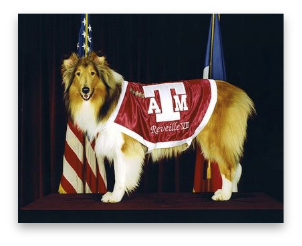
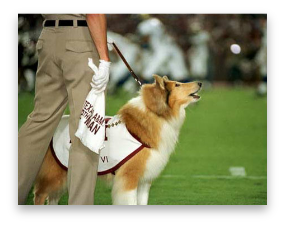
Our resident pooch, Cocoa, insists that we cast our vote for best mascot for Reveille, who represents Texas A&M. History says that in 1931 a group of cadets returning to school hit a small dog. They picked her up and brought her back with so they could care for her. The next day, when reveille sounded, the recovered dog barked along and promptly earned her name. Reveille became the mascot for the football team and when she died, in 1944, she was given a full military funeral. All the recent Reveille representatives have been female Collies. Reveille is cared for by the Corps of Cadets and is the highest ranking member of the group. In what Cocoa thinks is a brillant move, the Aggie mascot is referred to as "Miss Rev, ma'am." She is so revered on campus that if she barks during a class it is immediately dismissed for the day. If she chooses to sleep on a cadet's bunk, he must cede it to her and sleep on the floor. There's a special cemetery for all the Reveilles at the north end of the stadium so they can always watch the Aggies play. In October 2010, Reveille VIII joined the Aggie team.
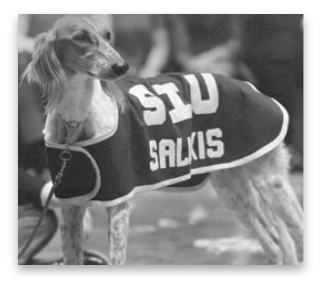
Earning the title of most royal of all canine mascots are the Salukis of Southern Illinois University. Since becoming the team mascot in 1951, this dog with the royal Egyptian lineage has had some illustrious representatives. In 1956, the second and third Salukis joined the SIU family. The male, Burydown Datis, came from the famed kennels of Hope and David Waters, in England. (Just to get in a book plug: They would go on to author the excellent The Saluki in History, Art and Sport. Click here to see the copy in our ebay store.)
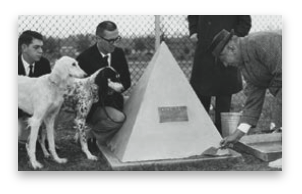
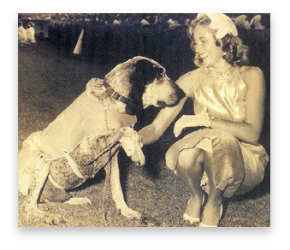

There have been nine Smokey Blueticks in all. Rev. Brooks continued to supply the university with hounds until his death in 1986. His wife Mildred continued the tradition until 1994 when the honor passed to her brother.
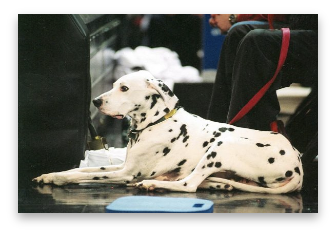
For years, Providence College was known for its Dalmatian mascot. The Friars Club purchased Friar of What-Ho in 1935 and donated him to the school. The school website says: "The choice to use a Dalmatian was one close to the heart of the Dominican brothers who founded the school. The pope even refers to the Dominican brothers as 'watchdogs of the Lord.'" Friar was an immediate hit on campus. Two years later, when Friar passed away, he was replaced with Friar Boy. There followed four other Dalmatians. Friar Boy IV died in 1963 and for 30 years no Dalmatian donned the Providence colors. For the 75th anniversary of the College's beginning, in 1993, the Dominican brothers bought Friar Boy V. The dog became a favorite on campus and appeared at all the basketball and hockey games. Sadly, he passed away in 2001 and has not been replaced. Let's hope that a "Bring Friar Boy Back" campaign begins at Providence.
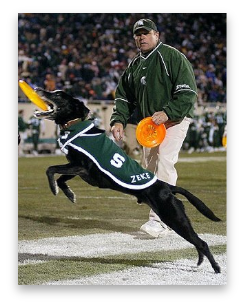
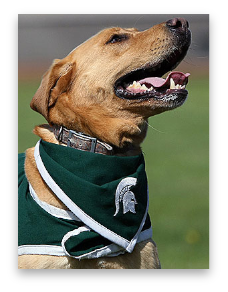
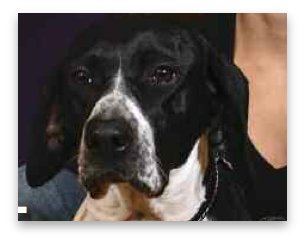
For years, the University of Wisconsin at Steven's Point featured a costumed mascot known as Stevie Pointer. He would later be joined by a female mascot named Stephie. During the 1970s, though, Stevie appeared with a genuine canine counterpart named Patty Pointer. In 2008, Chancellor Linda Bunnell decided to revive the tradition and her assistant adopted McKenzie, a two year old Pointer. McKenzie was just a day away from being euthanized at a Kentucky humane society when a rescue group called Pointers from Oz heard about her plight and stepped in. Now, the new mascot can be seen around the campus clad in a purple sweatshirt. She has a full time trainer, too, a student who has been training dogs since the age of 13 and, before coming to college, taught classes in agility.
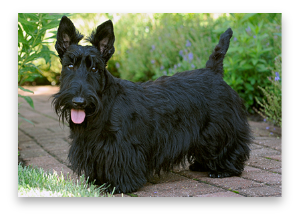
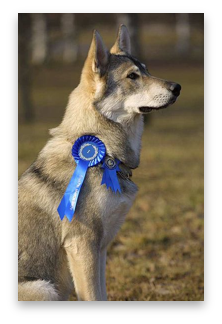
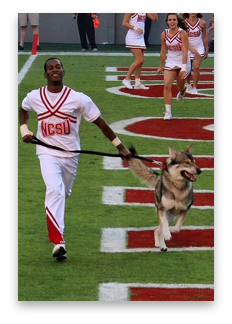
This year a truly rare breed joined the ranks of college mascots. What do you do if you really really want a live mascot, but your team is known as the Wolfpack? That's the dilemma that faced the fans at North Carolina State University. They tried using actual wolves, but the animals were just too shy to serve as mascots. Then they learned about a rare breed from Finland—the Tamaskan Dog—that had a truly wolf-like appearance. Finnish racing huskies were crossed with Alaskan Malamutes, Siberian Huskies and German Shepherds to create this new breed which was registered for the first time in 2002. Wave (better known to fans as Tuffy) is now the official mascot of the NC State Wolfpack.
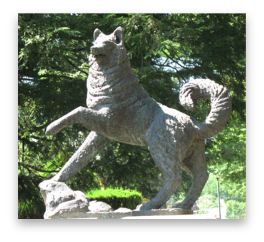
Happy Collecting,
Cathy, Harvey & Cocoa
P.S. Well, the dogs triumphed. The Wofford Terriers defeated my JSU Gamecocks. Go luck Blitz II and the team.
P.S.S. A big thanks to the colleges for allowing us to use the photos of their mascots. A special thanks to "Big_Fan," one of my favorite contributors to the excellent gojaxstate forum, who photoshopped the wonderful Thanksgiving image we used at the start of this newsletter. I'd have asked his permission, but I'm having trouble logging on to the site. I hope he won't mind.
